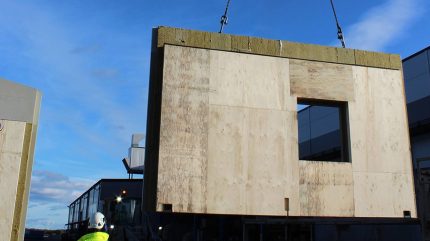
Swedish concrete element manufacturer Heidelberg Materials Precast Contiga and engineered wood products manufacturer Metsä Wood have introduced a hybrid wall element with a reduced carbon footprint when compared to conventional wall elements.
The product, designed for use in buildings up to five floors, is claimed to be now ready for use in commercial construction projects.
The hybrid wall element is a sandwich construction facade element suitable for residential buildings, offices, healthcare facilities, and schools.
Heidelberg Materials Precast Contiga division manager Daniel Eriksson said: “The production method is very similar to what we already have, so we can create these hybrid elements using the same approach as our other walls, and they are assembled in the same way.
“We haven’t made any major investments or modifications.”
The solution combines an outer layer of climate-improved concrete with intermediate insulation and a load-bearing inner panel made from Kerto LVL.
Kerto LVL is a strong and material-efficient laminated veneer lumber.
This combination is expected to result in a 30%-50% lower climate impact compared to traditional concrete sandwich elements, as well as lower transport costs due to its lightweight design.
Metsä Wood business development manager Håkan Arnebrant said: “One of the advantages of this hybrid element is that construction contractors do not have to change their way of building with concrete elements but can still lower their carbon dioxide emissions.
“At the same time, the walls can be made 50mm-75mm thinner than walls built with concrete elements, which can give quite a few extra square metres in a building.”
Precast Contiga initiated collaboration with Metsä Wood nearly two years ago to produce these hybrid elements for the Swedish market.
The test building at Norrtälje is fitted with moisture sensors to monitor the wall elements’ interior conditions, which are claimed to have shown no signs of moisture.
The test also included experimenting with various installation solutions.
Last year, Consolis Parma, housing developer Arkta Rakennus, and Metsä Wood commenced a research project on hybrid construction.



